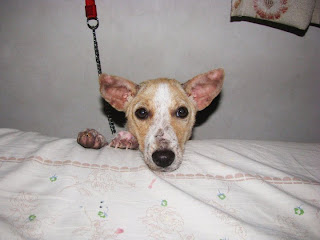One of the truest sayings I have come across, it perfectly describes the human nature- devoting more time speaking rather than listening to others. We cut in impatiently whenever we think that we are not getting the opportunity to put our opinions across satisfactorily, and zone out when the other person starts speaking. But sometimes it is just important to listen, not only because it makes the other person feel good, but for our own sake as it gives us a chance to introspect. When we are so inattentive to the words of another human, how could we possibly expect to understand the language of mute creatures?
Animals are the best listeners because they ask no questions and they do not judge. But often we make the mistake of thinking that just because they can’t speak, they have nothing to share. Those of us who share very strong bonds with our pets would vouch for the fact that they communicate through an unspoken language - their touch, looks, calls and body language constitute a language of its kind-no less effective in conveying their emotions than our spoken language. An animal will just sit beside you for a long time, sharing your solitude and enjoying your company. Many a time when I am working on my laptop or reading, my cat would start nuzzling and brushing against me in a sudden display of affection. He would shower me with loving gazes and make loud purring noises to get my attention. If he fails in his endeavor, he would get trifle irritated and put a complaining paw on the laptop keyboard or on the book and meow pleadingly. This would be my cue to give him a tight hug during which he would close his eyes, go completely still and purr his heart out. If by any chance I do not oblige, he would give me an indignant nip, walk off in a huff and would pointedly ignore me until I make amends by giving him fishy treats. One of my tabby cats actually used to pull at my clothes if I didn’t acknowledge her presence!
When I had brought my dog home from the shelter, she was only six weeks old. She was suffering from a bad skin disease and because of the strong ointments I had to administer on her (which obviously caused her a lot of pain) she developed a kind of phobia towards me. She stopped wagging her tail and trembled out of fear whenever I went close to her. She bit me a number of times while I was applying medicine and she would eat only if my mom served her food. It was as if she was waging a cold war with me. I tried every way possible to pacify her, short of stopping the treatment. Gradually, her skin disease started reducing but her antagonism remained unabated. One day, when I had taken her to the terrace for her evening run and was sitting on parapet, watching her gamboling amongst the flower pots, she suddenly bounded up to me. She hesitated for a second and sniffed at me tentatively. Then she came and sat beside me, looking at me from out of the corner of her eye. After I was certain that she was comfortable, I patted her on her head. She stared up at me for a long time, and I continued patting her in silence. I examined her skin rashes and bruises closely, a task which had lately become impossible. She made soft whining noises when I touched a particularly tender spot, but made no attempt to go away. I understood the terrible pain she must feel when I wash those painful areas with raw Betadine. I gave her a hug and she moved closer to me and leaned her head on my arm. We sat for a long time, watching the sun set, each lost in our own thoughts but somehow finding comfort in each other’s company, and from then on till I left for Mumbai, I made it a point to spend some time with her, just the two of us. We came to understand each other much better and I often felt that during that little time of our own, she would try to make up for her bad behavior during the treatment by offering me twigs and bits of dirt which she found on the terrace, or planting muddy paws on my shoulder and licking every inch of my face.
Just like humans, animals also want to spend their time with those whom they love. We consider our pets to be our companions in solitude because it is with them that we can be completely our own self. But do we also give them the same level of comfort? Do we understand their need to share their solitude with us? Do we give our pets enough time to bond with us? Having a pet is a lifelong commitment from which there is no backing out. We should never make an impulsive decision if we are not emotionally and mentally ready to devote time to a pet as it can cause a lot of pain for the animal we bring into out life.



















